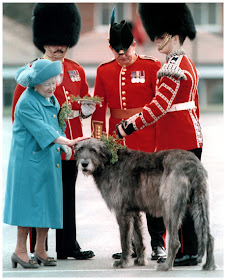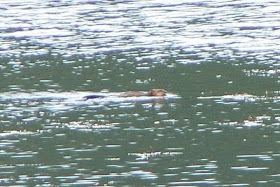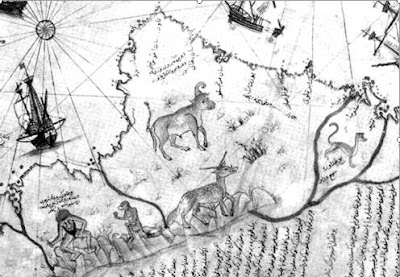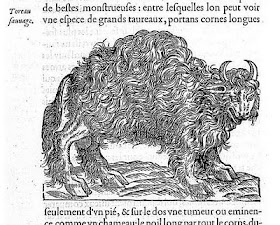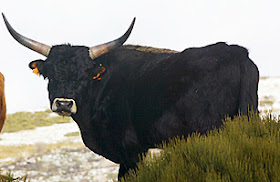Lake bulls or “water bulls” have been seen and reported in many Patagonian lakes. They are aquatic bovids and as such, are quite different from the other cryptids mentioned in previous posts (i.e. the snake-like culebrón and flying snake and the ray-like
cuero or the slender hariy
guruvilu).
Water bulls are bulky, sturdy, aggressive and obviously bull-like beings.
Today I will bore you to tears with
Everything that you ever wanted to know about Patagonian lake bulls.
Lake Bull stamp. Copyright © 2009 by Austin Whittall
Why bulls?
They are known as bulls, not pigs or goats or llama. Why?
They are described as bulls; in some cases they are also called as cows. But either way, they are bovines (like the run of the mill domestic cattle).
The fact that they are described as bovines means that their appearance must be strikingly similar to that of a cow or a bull. (Would you call a long necked cryptid a “lake hippo”? or would you call it a “lake giraffe”? I think that you’d call it what it resembled most, i.e. giraffe).
That is why I believe that the “water bulls” look a lot like bulls.
Bull, what makes something look like one?
Within the order
Artiodactyla is the family
Bovidae, this family includes many species such as goats, sheep, buffalo, cattle and antelopes.
Bovidae differ from the other artiodactyls (such as deer) because they have horns.
Horns are a key feature that allows anyone to tag an animal as a bull or a cow (even toddlers can do that).
If the natives have “water bulls”, then be sure that they have horns.
Horns are a bony nucleus surrounded by a keratin sheath. They are unlike deer horns because they are never shed and they do not branch, they keep on growing during the animal’s life.[1]
All male bovids (i.e. bulls) have horns (and about two-thirds of the species have horned females –i.e. cows).
Within the Bovidae is a subfamily, the
Bovinae whose members vary in size from the Gaur (
Bos gaurus, which can measure 2.2 m high at its shoulder and 3 m long, (7.2 and 9,8 ft. respectively) it can weigh up to 1,000 kg (2,204 lb.) to the tiny Vechur cow which has a maximum height of a 91 cm (3 ft.) and weighs on an average 107 kg. (236 lb.). [2]
Finally we have the
Bovini tribe, which comprises the domestic cattle, the yak and domestic buffalo, the American bison and the African buffalo. All of them, except the American buffalo, are Old World animals.
The American bovids are recent arrivals in the New World, having crossed the Bering land bridge between Asia and America about three million years ago. They never expanded their range into South America.
Cows and bulls (domestic bovines) were brought to America by Europeans after its discovery by Christopher Columbus in 1492.
Nevertheless, I have researched on the possible existence of South American bovids in pre-Hispanic times and I have made some interesting discoveries. I will post about them later, next week.
Comment: We can conclude the following
- No endemic bovids in South America or Patagonia.
- Cattle introduced into America by Spaniards after 1492.
- Bovids have horns. This is a feature that characterizes them.
- Bovids can be very big or very small. Size is not uniform.
Lake Bulls, a global myth
Bulls have been integrated into myths of people all around the world, from the Cretan Minotaur to the Biblical Golden Calf and the ancient Egyptian’s Apis. The Greeks named a constellation after it (Taurus), which is relevant to those who believe in astrology
The heathen Northern Europeans had a “water bull” that can also be found in the British Isles; it is a hornless bull, smaller than a regular cow, which “
associates with domestic cattle” improving its stock and dairy yield. [3] We will see that in this (its relationship with cattle) it is similar to its counterpart in the Andean Puna region of South America. Read my previous post on
the Scottish “water bull”.
It should not surprise us that bovids were incorporated into the North American native’s myths such as the Lakota’s “White Buffalo woman” [4], after all, there were buffalo in North America.
What is surprising however is that they appear in South American myths since there were no “native” bovids there. There are two possible explanations for this apparent anomaly:
1.South American bull myths originated
After Spanish conquest. The natives, confronted for the first time with an angry bull would very quickly assign it mythical or supernatural status. Domestic cattle would be a marvel to them. And a bull impregnating cows a clear symbol of power and fertility.
2.There was some kind of
cryptid South American cattle. Which the Indians knew about and had incorporated into their lore. Cattle which is now extinct.
I must admit that option "
1" sounds more probable.
A list of lakes where “lake bulls” have been seen
Lake Caviahue (37°52’ S, 71°02’ W). Located in northwestern Neuquén, it is a small horse-shoe shaped lake, with a surface area of only 10 km
2 (4 sq. mi.) It was a sacred place for the Mapuche natives, and according to Argentine folklorist Gregorio Alvarez, in the lake there were:
animals that should not have been there, like threatening bulls and horses […] [5]
Lake and Creek at Aucapan (39°38’ S, 71°17’ W). A small pond, it is home to the “
Huaca Mamül”, a cow-like creature, whose name in Mapudungun (the language of the Mapuche natives) means “cow stick” (“
huaca” = cow and “
mamül” = stick).
The creature is said to bellow like a cow with a sharp and explosive “
Aaaa…”; it is described as a “
live stick” (
palo vivo in Spanish) which is found “
in the middle of the forests between Aucapan and Chile, in a tiny hidden lake”.[8]
The living stick is not some kind of magic piece of wood or log, it is named so in a metaphorical manner because it buoys in the lakes just like a drifting log, but it is alive, and stands upright moving at will and it destroys all that come near it.
Close by, at Aucapan Creek, there is a pool, which the locals avoid because “
cow heads” are seen surfacing in it.[8] Perhaps both creatures are the same one.
Lake Huechulafquen (39°46' S, 71°23' W). Just south of Aucapan. Is home to a creature that Alvarez describes casually mentions among several other strange animals which he calls zoomorphs. This animal is the "
cow at Lake Huechulafquen".[9]
Unfortunately Alvarez gives no description of the beast and I have not been able to find any other articles or books mentioning this creature.
Lake Lolog (40°01’ S, 71° 26’ W). Located on the eastern side of the Andes and surrounded by forests. It flows east through the Quilquihue River into the Chimehuin River which in turn drains into the Atlantic via the Limay and Negro rivers. It is connected upstream through the Chimehuin river to Aucapan and Huechulafquen.
In 1960 a local named Sabino Cárdenas reported that “
animals appear” in the lake, looking like “
a cow [that surfaces]” however, if pursued “
it sinks into the lake”.[10] This same creature is described as a "
gigantic cow that is sometimes seen swimming in [the lake]".[11]
Bertha Kossler Ilg, describes it as a “
marine bull”, a “
giant bull that harms cows” it mated with them but they gave birth to “
very deformed animals, some with six, others with eight legs”.[21]
Interestingly, “
at night it came ashore to eat the good grass”[21]. A grazing lake bull!.
Lake Lacar (40°10’ S, 71°25’ W). A few kilometers south of Lolog. At Quila Quina on its southern shore, Mrs. Teodora del Carmen, saw in 1952 a strange amphibious animal on the beach by her home:
a bull with golden horns appears at night. He goes out and runs in the water. A loud noise can be heard when he is frolicking. He roars and makes a lot of noise […] my husband saw it. He said it was a black animal. It does not have hoofs like cows; it has its feet like those of a goose. It does not leave marks on the beach because it does not leave the water.[12]
At this same place, Mrs. Yolanda Curruhuinca, wife of the Mapuche Tribal leader Abel Curruhuinca, swore that she saw a “
fish with the head of a bull with golden horns”; once she witnessed a clash between “
a little water bull fighting a land bull”.[13]
Comment: Water and land indicate two categories of bulls based on their habitat. Does the “fish” part of the description mean “fish-like” of does it mean “aquatic”?.
Lake Rosario also
Laguna del Toro Negro (Lake of the black bull). (43°16’ S, 71°20’ W). Set on the edge of the steppe its shores are surrounded by ñire forests and with the mighty Andes are its backstage.
The local natives tell an ancient tale about a fierce black bull that lived by the lake that killed the son of an Indian chief who had tried to hunt it. The grieving chief in turn killed the bull, which, even dead, can often be heard howling and “
seen swimming in the lake”.[14]
Another version says that the lake was formed when a
White Bull “
one night, furious, pounded a water spring with its hoofs”. In this version the howling being is not the bull, but the spirit of the dead Indian.[20]
Lake Foitzick (45°38’ S, 72°05’ W). In the Aisén region, in southern Chile close to the town of Coihaique . It is home to “
The Bull of the Silver horns [that]
bellows”.[15] The lake’s shore is full of rushes and surrounded by swampy ground. It is quite deep and may be an extinct volcanic crater. It lies beyond the forests, in the steppe.
Lake La Plata (44°52’ S, 71°48’ W). It is located well inside the Argentine Andean forests.
Here, local people “
saw animals coming out of the lake” but when they tried to approach them, “
they rushed and back into the lake again”. At night they heard “
horses neighing, bulls bellowing and all kinds of animals bleating in the lake”.(bold font mine).
They were frightened because these “
lake animals want[ed] to take” their cattle into the lake.[16]
Comment: This “affinity” between lake bulls and cattle is a behavior that is observed in Europe, and, as I will mention later, also seen in South America.
Lake Cisnes (48°25’ S, 72°39’ W). Lies just north of the Southern Continental Ice Field beside Chilean Lake O’Higgins (San Martín in Argentina).
It is home to the “Animal in Lago Cisnes”, described as having the upper half of a cow, and its bottom part, of a black colored horse. “
In another version, the animal is half cow (above) and half water animal (bottom)”.[17]
An eye witness named Ernesto Bahamondez noticed on a day that the lake was very calm, that “
something dived into the water […] the front part was like a cow, the rest was a water animal, a fish […] it also walked on the lake” – perhaps meaning that it swam".[18]
Comment: Once again the “fish” element is present in this creature (see Lake Lacar above).
Lake el Toro (Bull Lake) (45°31'S, 71°51'W). This is a very small lake, roughly circular in shape, about 800 m (0.5 mi.) in diameter. It is set on the steppe, about 22 km east of Coyhaique (14 mi.) towards the Argentine border
Here, Wilson Aguilar tells us a story dating back to the 1930s about a mythical black bull. At the time, some cowhands were camped by the lakeside but they were awakened in the middle of the night by a large wave that surged in the lake. From this wave appeared a:
formidable bull that scared away the herd with its immense horns, it was of a never before seen black color […] a group of cows as if hypnotized followed the bull towards the middle of the lake [and drowned] [19]
A few years later at the same sport the bull reappeared, mounted a cow impregnating her. When the time came for the cow to calve, she gave birth to a “
calf that did not have legs but some beautiful fins; it was so small that it could not even reach the udder to feed [and died]”.[19]
Comment: Surfaces from the water, has supernatural power over the cattle. Mates with them but produces nonviable offspring (different species?). It also has a very aggressive behavior. This may not be a lake bull but something else, some other kind of cryptid.
These lakes, are outside of the "historic" Mapuche territory, now we will look into the Northwestern sightings of “lake bulls”, within their original homeland.
Lake Bulls in Northern Patagonia, in the Chilean Mapuche homeland
Temuco area (38º41’ S, 72º25’ W). This town which straddles the Cautin river, is very close to several sites where water bulls have been reported:
1. Perquenco. This town is just 16 km (10 mi.) north of Temuco, and it is located on the Quillén River (no relation whatsoever to the
Argentine river of the same name) which is part of the Imperial River basin. Here the “
Mapuche speak about the existence of a ‘water bull’ whose appearance is the usual one for these animals, but that instead of living on ground it lives in the water”[23]
3. Maquehua. Just a few kilometers west of Temuco, Tomás Guevara mentions that here, at Melivilu [*] :
Once a bull came out of a lagoon. Two Mapuche lassoed it […] took it home, killed it. They cooked its meat. When they went to see it, it was still red; they made a bigger fire [and it did not cook] This scared them so they went to throw it back in the lake. They met another bull and lassoed it [but could not eat its meat] [24]
They concluded that “
water animals cannot be caught and when they are caught, their meat cannot be eaten] [24].
[*] This same place has been mentioned in our previous post on
the guruvilu the “snake-fox”. )
To the north, along Patagonia’s northern edge, Bio Bio River, there was another “water bull” sighitng at:
Estanillán Lagoon (37°39' S, 72°01' W). This body of water is quite close to Quilaco, and is home to a “
water bull that is captured with the help of a wizard and his assistants: witch dogs”. [22]
In this case the animal has a supernatural aura and it took a wizard to capture it.
Coincidentially, Quilaco is just across the Bio-Bio River from the town of Santa Bárbara, where, in 1914, a
strange reptilian-like water creature was reported.
The Inca link. A possible clue to the water bull myth
Illa or
Ylla is an ancient myth of Andean (i.e. Inca, Peruvian) origin, it was recorded by the Spaniards as having a sacred meaning, and formed part of their words for light and lightning.
Spanish priest González Holguín, recorded it in his Quechua language vocabulary (1608) as “
Ylla […] all that is ancient of many years and secluded” [25]
This coincides with the meaning assigned to the word by the Puna natives according to
Peruvian ethnographer and writer José María Arguedas: [26]
the bulls that live in the bottom of the lonely lakes are illas, in the high lagoons surrounded by bull rushes.[…]
The cultural flow promoted by the Inca empire, as it expanded south into what now are Bolivia, Argentina and Chile, spread the concept.
It is still found in the Bolivian and Argentine Puna region where it is found as the myth of the “
Toro Illa” in Argentina’s northernmost province of Jujuy –closest to the myth’s place of origin, and further south, as the “
Toro Aspas / Astas de oro” (Bull with golden horns) in Catamarca Province.
The Jujuy version has it as a bull with golden horns that protects the cattle. It lives in the mountains or
in a lagoon (bold font mine), it gathers the cows around it by the lagoon and is a benign being. It kills rustlers and multiplies the herd. [27]
Argentine Folklorist Bertha Vidal de Battini, noted that “When it appears,
the cattle gathers close to a lagoon” (bold font mine). [28]
In the province of Santiago del Estero, the
Toro Supay or
Toro Diablo (Devil bull) also has a golden horn, it is gigantic yet, it also protects the herd. [27]
Notice the recurring "golden horn" motiff which is identical to the Lake Lacar bull, which also has golden horns. Coincidence or cultural flow from Inca to Mapuche?
We see in these Inca and northern Argentine myths a very close relationship between the bull figure, the lake habitat and the bond between normal / regular cattle and this supernatural bull. And these elements are strikingly similar to those found in the cases mentioned in Patagonia (i.e Lake Toro and La Plata). This may also indicate that the Mapuche myth has an Inca origin.
If this was so, it wasn't the only myth they absorbed from the Inca, for instance, I believe that the
"flying snake" was also acquired from the Inca.
Mapuche: Bulls and the supernatural
Within the Mapuche homeland outside of Patagonia, the lake bull appears again, but with magic, almost religious connotations. In this it is different from the Patagonian animal which is much more mundane:
Well beyond northern Patagonia, close to Santiago, Chile’s capital city, is another lake with a bull:
Laguna del Toro (30°00'11"S, 70°22'23"W). This is a rugged mountainous area, and the lake is at 3.232 m altitude (10,600 ft.), it is quite close to the Argentine border and in a very arid region close in Los Andes, by the Blanco River:
There is a bull whose roars can be heard only one night a year [29]
This is evidently a magic bull (its “once a year” concerto indicate that), furthermore, its location is within the range of the Inca occupation of Chile, by the “Inca Road” that crossed the Andes into Mendoza through Uspallata.
Nahueltoro (36°29’S, 71°46’W). This place is also outside of Patagonia, about 120 km (75 mi.) north of its border along the Bio-Bio River.
Set beside the Ñuble River, its name is the combination of the Mapuche word
nahuel = jaguar and the Spanish word
toro = bull, and alludes to a native myth:
the puma-bull with formidable golden horns […] More than one [native] chief believed he incarnated the strength and war power of these two animals and named himself after them. That is why there are references of an Indian chief named Nahueltoro whose domains coincide with this site[30]
Chilean folklorist Orestes Plath adds that it was a bull, (not a water bull) with golden horns. [31
These non aquatic bulls may also be related to other myths such as
Lobo Toro, or if they aren't, they definitively refer to another animal.
Feral (wild) cattle
Laguna del Toro. (40°45’S, 72°18’W) [33]. At Osorrno, well inside the Chilean Patagonian lake district is this small lake. It was the territory of a wild bull of the “regular” (i.e. not a water bull) kind. It was a
bagual or feral animal.
In his myth, we see that the Mapuche could distinguish one kind of creature from the other. [32]
Feral Cattle, could offer an explanation to the myth, because they have often been seen in Patagonia close to the water, frolicking in the lakes: Prichard at Lake Argentino (1901) saw an “
old yellow bull knee-deep in the lake, drinking”.[34]
I have already posted on
Patagonia's wild cattle so I won't write about them here, however it seems clear that they were distinct from the "water bulls".
Etymology of the word
Etymology is the study of words, of how their form and meaning originated and evolved over time. It is interesting to notice what words were used by the natives to name cattle / cows. It can give us a clue to whether the animal was “local” or a late arrival (i.e. brought from Spain): [35]
(For more info, see my
Map and summary on Patagonian natives)
Mapuche Chile:
ofisa
Mapuche (Puelche):
ovissa
Spanish: Oveja
Teushen (Boreal Southern Tehuelche):
ssáa
Aonikenk (Austral Southern Tehuelche): - - -
English meaning: Sheep
Mapuche Chile:
kawellu, kawell
Mapuche (Puelche):
cahuellu
Teushen (Boreal Southern Tehuelche):
ká:wul
Aonikenk (Austral Southern Tehuelche):
kawul
Spanish: Caballo
English meaning: Horse
The two examples given above clearly point out that horses and sheep were foreign. The native name is a good reproduction of the sound of the Spanish name.
However, when it comes to cows the situation is different:
Mapuche Chile:
waka
Mapuche (Puelche):
huacá
Teushen (Boreal Southern Tehuelche):
ch’oi or
choji
Aonikenk (Austral Southern Tehuelche):
tr’oi or
chói
Spanish: Vaca
English meaning: Cow
The Mapuche word is very similar to the Spanish one, but the Tehuelche word is totally different. Furthermore, the Gennakenk or Northern Tehuelche had an even more difficult word for cow:
Treye or
Treyie. [36]
In my opinion this shows that the Tehuelche groups on the eastern side of the Andes in the steppe area of Patagonia had a pre-Hispanic word for cow probably associated to a local bovid:
native pre-hispanic cattle. (More on this in future posts).
A Mapuche myth that migrated into Patagonia
The myth is definitively a Mapuche myth as I have not found any references of Tehuelche myths involving bulls or cows.
The following map will help me show you how I believe the "water bull" myth expanded into Patagonia.
Lake bull or water bull. Map showing distribution of sightings.
Copyright © 2010 by Austin Whittall
The sites where "water bulls" have been reported are marked with red dots.
In the upper right corner, just south of the Bio-Bio River and around Temuco, is the core of the Mapuche territory. Here they held out against Spanish dominion between the mid 1600s and the 1880s. The myth, of Inca origin, filtered into this area and from here moved across the Andes where the local Pehuenche and Manzanero people in Neuquén absorbed it together with the Mapuche language during their "Araucanization" process in the 1700s. The violet circle shows the main base of the Manzanero Indians before their defeat by the Argentine Army in between 1879 and 1884.
The remaining natives moved south into Chubut where they finally settled around 1905 in Nahuel Pan (green circle). However they were evicted from there in 1937 and many roamed across Patagonia, working as laborers on the sheep farms. Many settled around Lake Rosario (blue circle), where, unsurprisingly a "water bull" has been reported.
The myth, hand in hand with the laborers, moved into the Chilean sheep farms around Coyhaique (orange shade on the map) and from there along the southern Route 5 to its souther terminus at Villa O'Higgins.
The map clearly shows that there have been no sightings outside of these areas in eastern Patagonia, the land of the Tehuelche, which supports my contention that the myth is a Mapuche one.
Summary and closing comments
We have two kinds of bulls in Patagonia, the
Wild / feral / Bagual bulls, which are just cattle ran wild in the forest. They may be mean and dangerous but they are not cryptids.
Then there is the
Water Bull which is found across Patagonia, from its Southern tip to its northern reaches.
Beyond Patagonia, in the central part of Chile, where the Mapuche had their original homeland before the Spanish Conquest, we have a
magical Bull, which has evident Inca religious significance, this was perhaps imported during the XV
th Inca invasion of Chile. A similar myth is found on the Argentine side of the Andes, all the way up to the Puna (all within the former Inca empire's territory).
The mystery remains. Its origin
Was the myth a pre-Hispanic myth inspired by a yet unknown Andean cryptid and then was passed on to the Mapuche by the Inca? or was it formed in the former Inca empire after the Spanish conquest once they introduced cattle into America and then moved on towards Chile?
Was the myth inspired by some unknown creature in the Inca times and then was assigned to the newly arrived European bull?
Was there a local Patagonian bovid?
These questions will remain unanswered for now. My next post will address the "horned" cryptid issue, in other words, a "native Patagonian cow".
Bibliography.
[1] Bies, L. A., and Myers, P.,
Horns and antlers University of Michigan.
[2] P K Uthaman.
World’s smallest cow rescued from extinction
[3] Eberhart, G., (2002). Op. Cit. pp. 580.
[4] Leeming, D., A., Page, J., (1996).
Goddess: myths of the female divine. Oxford University Press US, pp. 36. 199
[5] Alvarez, G., (1968).
El Tronco de Oro. Neuquen: Pehuén. pp. 116 -7.
[8] Fernández, C., (1995).
Cuentan Los Mapuches. Buenos Aires: Ediciones Nuevo Siglo. pp. 75+
[9] Alvarez, G., Op. Cit. pp. 114.
[10] Fernández, C., (1995). Op. Cit. pp. 44.
[11] Rojas, R., (1925).
Literatura Argentina: Ensayo filosóofico sobre la evolución de la cultura en el plata. Librería la facultad. pp. 94.
[12] Fernandez, C., (1995). Op. Cit. pp. 74.
[13] Totha, J., (2007).
El paraíso queda en Quila Quina. La Nación. Buenos Aires, Argentina. 18.03.2007.
[14] Fernández, C., Op. Cit. pp. 70.
[15] Mansilla Contreras, J., (2008).
Los Compañeros en una Tierra Solitaria. Diario el Divisadero. Coyhaique, Chile. 15.01.2008.
[16] Vidal de Battini, B. E., (1980).
Cuentos y leyendas populares de la Argentina. Buenos Aires: Ediciones Culturales Argentinas v.7. pp. 307.
[17] Mansilla Contreras, J., (2007).
Relatos Orales Aisensinos. Diario el Divisadero, Coyhaique, Chile. 16.10.2007.
[18] Villa O'Higgins Expediciones. Villa O'Higgins. Aysén, Chile. Historias Patagónicas. Online.
[19] Corporación de Defensa de la flora y fauna (CODEF) y Corporación de Desarrollo de Aysén (CODESA), (2000). Testimonio de Wilson Aguilar, de Villa Cerro Castillo. Relatos de antiguos pobladores de Cerro Castillo. Municipalidad de Río Ibáñez.
[20] Fiore, J., and de Vera, G., (2002)
Trevelín: un pueblo en los tiempos del molino. Municipalidad de Trevelín. pp. 92.
[21] Kossler-Ilg, B., and Foerster, R. (2006).
Cuenta el pueblo mapuche: Cuentos y fábulsas. MN Editorial. pp.23.
[22] Kuramochi, Y., (1997).
Cultura Mapuche: relatos, rituales y ceremonias. pp. 253.
[23] Aguirre, Sonia., (2003).
Mitos de Chile: diccionario de seres, magias y encantos Random House Mondadori. pp. 416. Online:
[24] Guevara, T.,
Psicolojía del pueblo araucano pp. 333.

[25] González Holguín. (1608).
Vocabulario de la Lengua General de todo el Perú llamada Lengua Qquichua o del Inca.
[26] Arguedas, J., M., 81983) [1941] Yawar Fiesta. In:
Obras completas. 69-227. Lima: Ed. Horizonte, t. II.
[27] Colombres, A.,
Seres Mitológicos Argentinos. Op. Cit. pp.264.
[28] Vidal de Battini Berta Elena, (1984).
Cuentos y leyendas populares de la Argentina.Ediciones Culturales Argentinas. v. 8. pp. 893.
[29] Aguirre, Sonia. Op. Cit. pp. 274.
[30]
Mitos y Leyendas del Antiguo Coihueco (Vol.4).
[31] Plath, O., Geografía del mito y la leyenda chilenos.
El toro de Nahueltoro
[32] Ibidiem. Provincia de Osorno.
La Laguna del Toro. pp. 280.
[33]
Online
[34] Prichard, H. Op. Cit. pp. 239.
[35] Dictionaries by; Barbará, F., De Augusta, F., Casamiquela, R. Op.Cit.
[36] Claraz, J. (1988).
Diario de viaje de exploración al Chubut, 1865-1866. Buenos Aires: Marymar. pp. 151.
Patagonian Monsters -
Cryptozoology, Myths & legends in Patagonia
2010 International Year of Biodiversity
Copyright 2009-2010 by Austin Whittall ©


